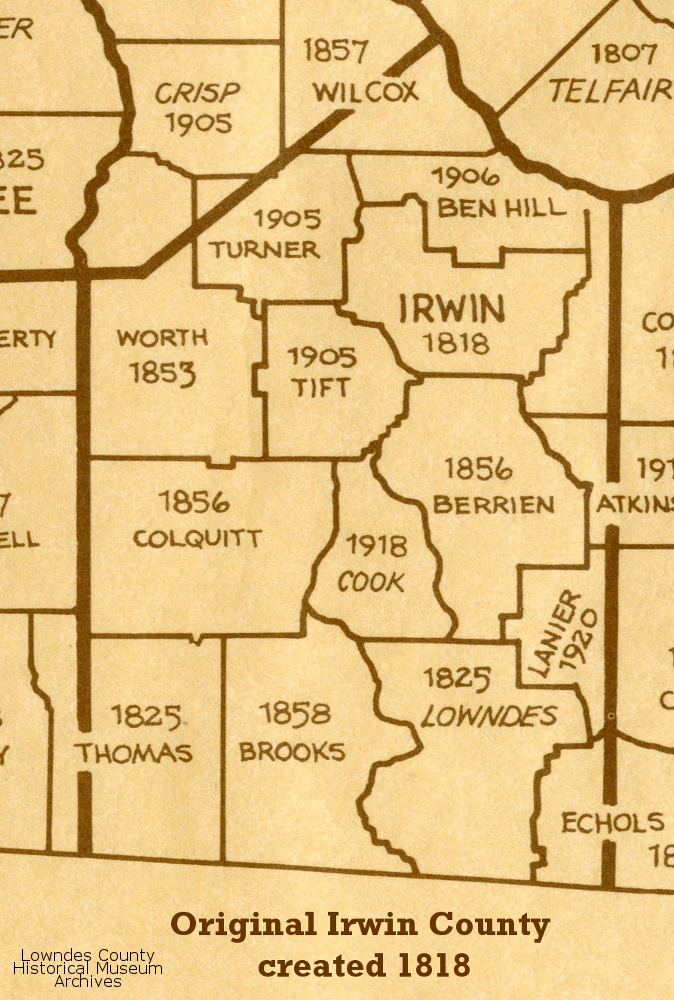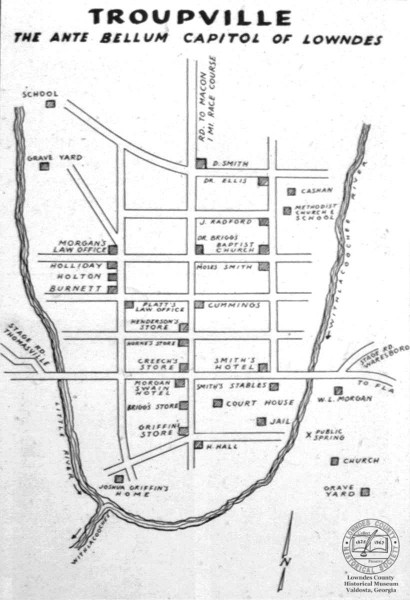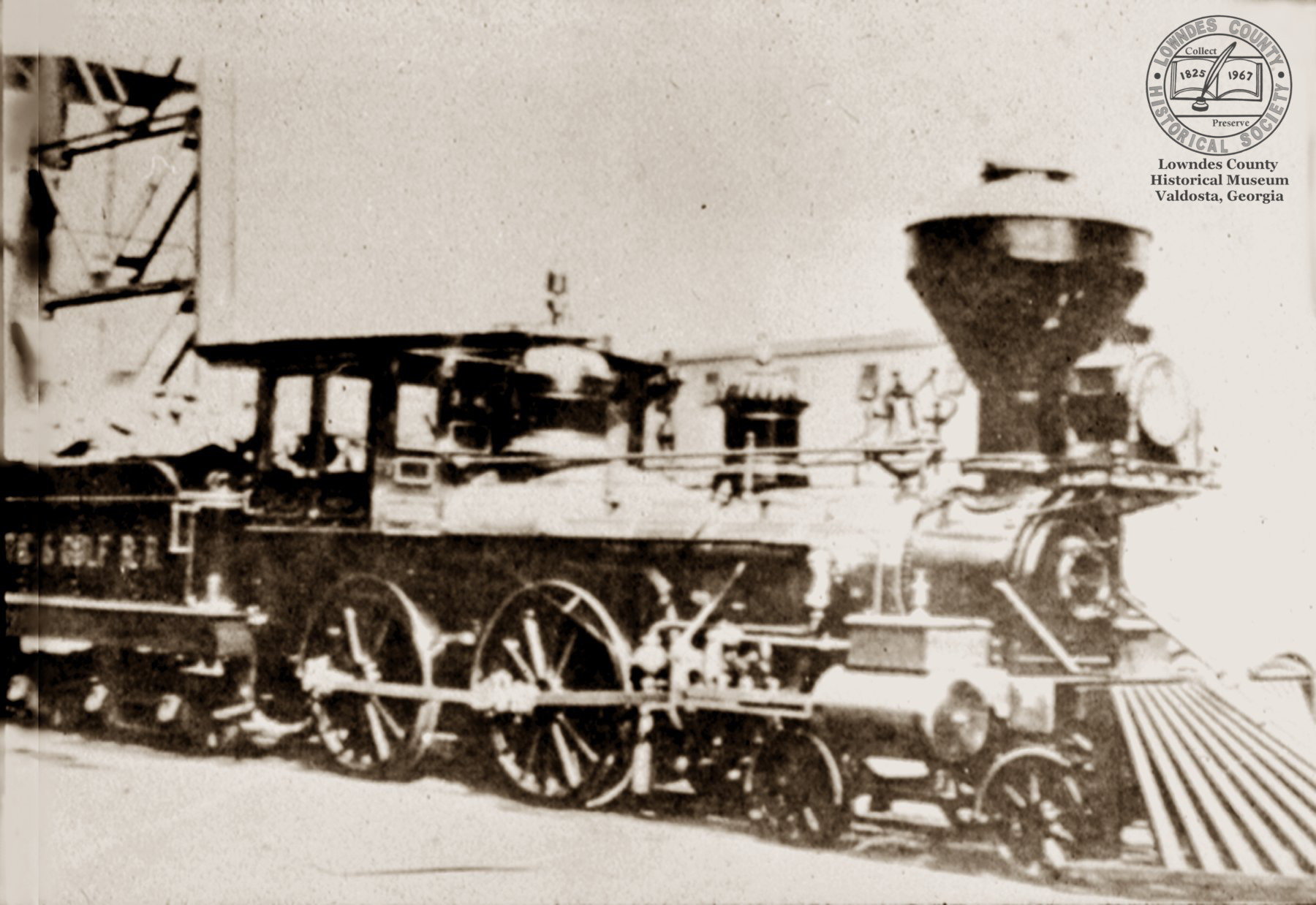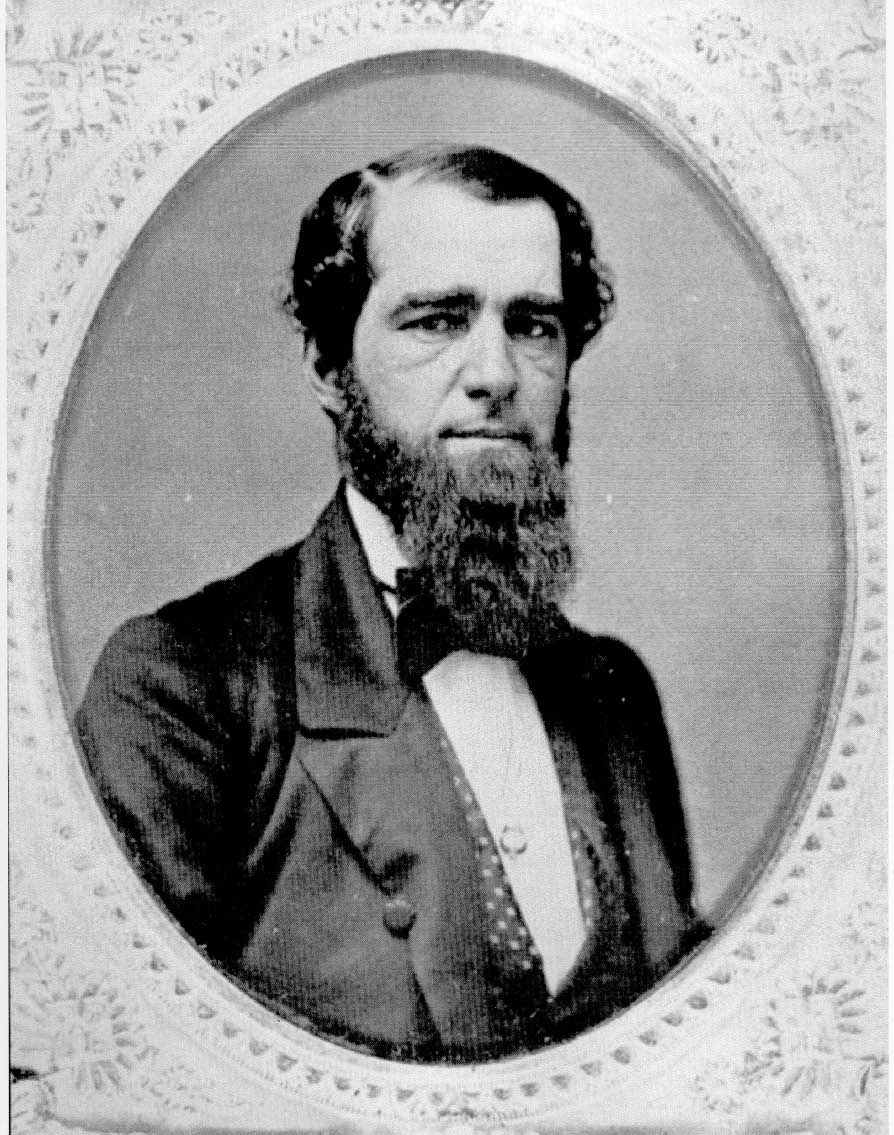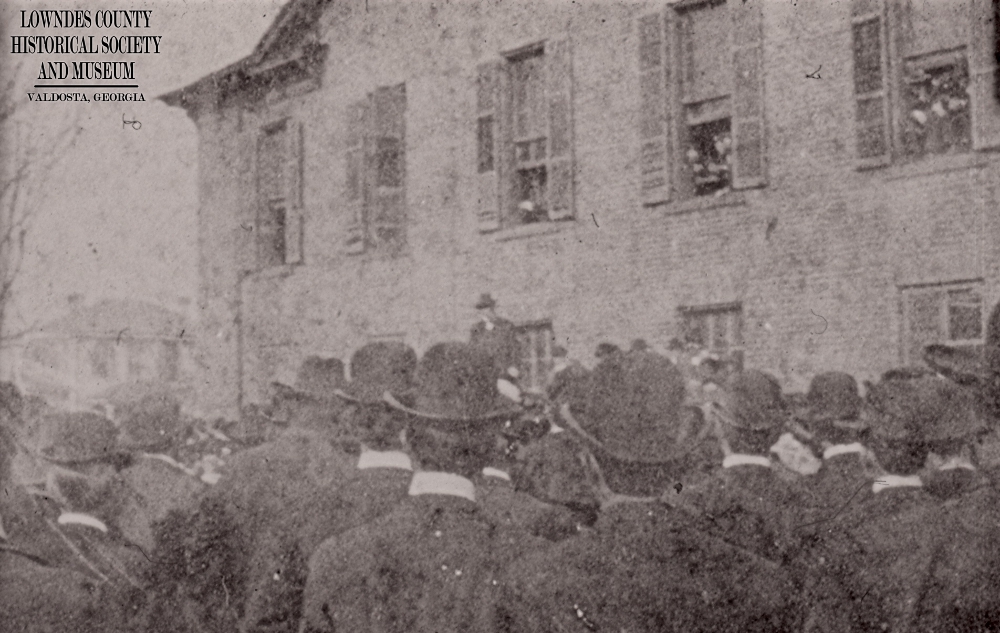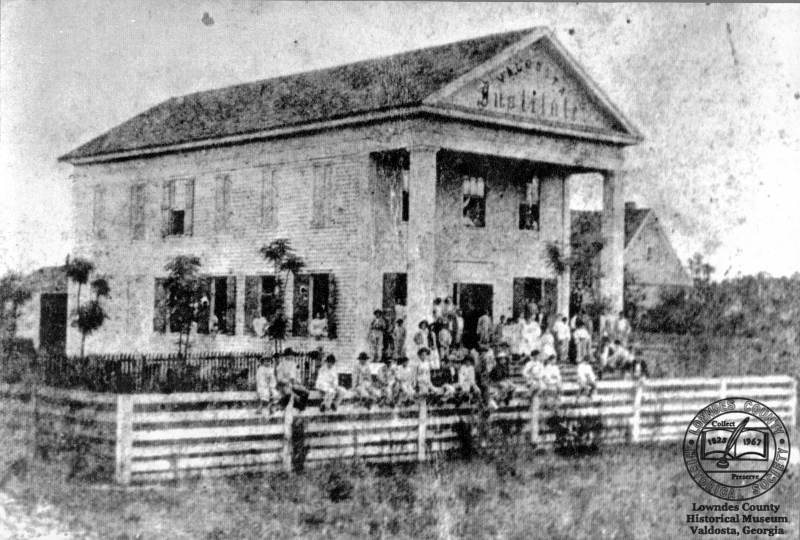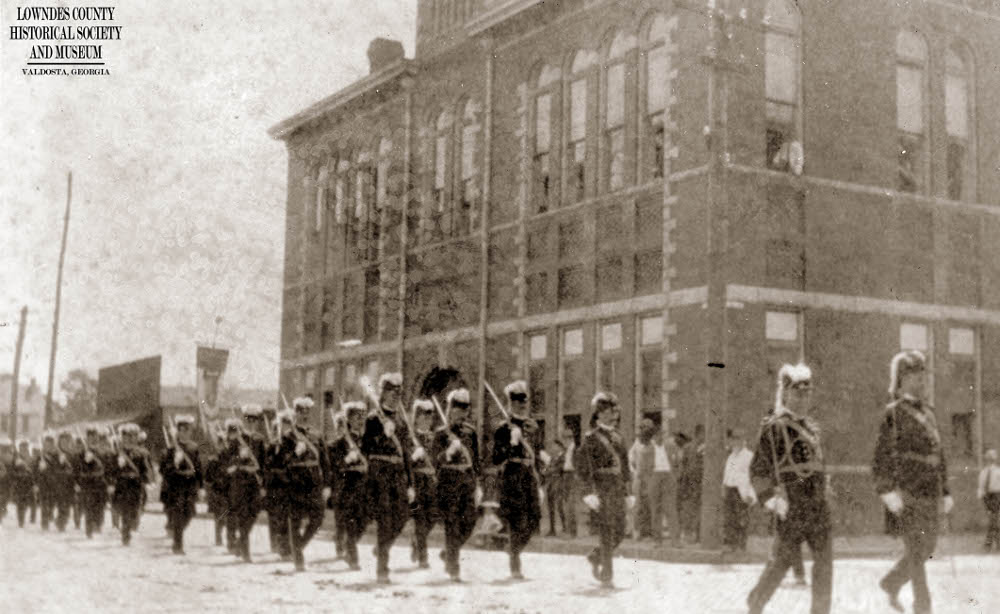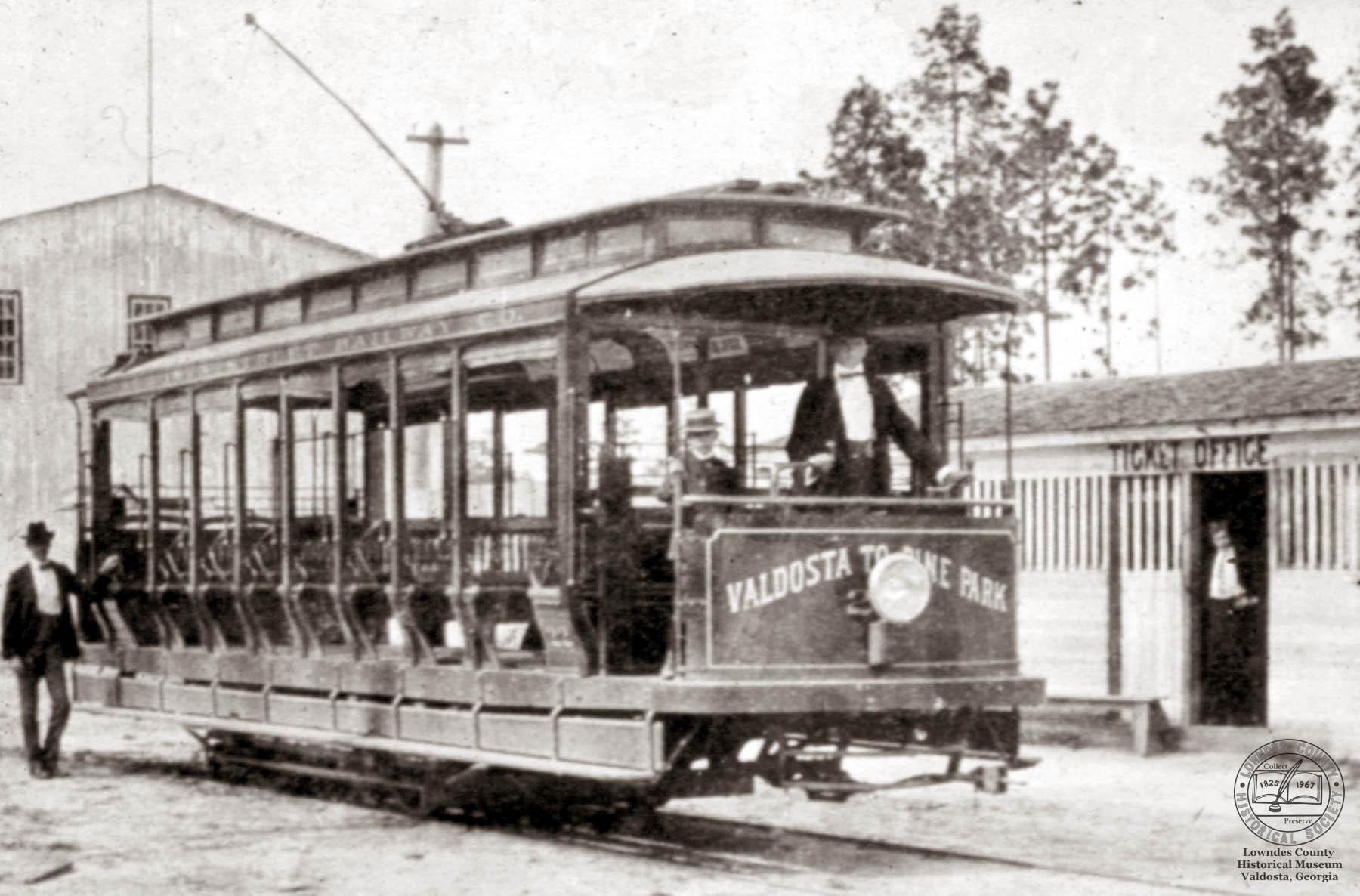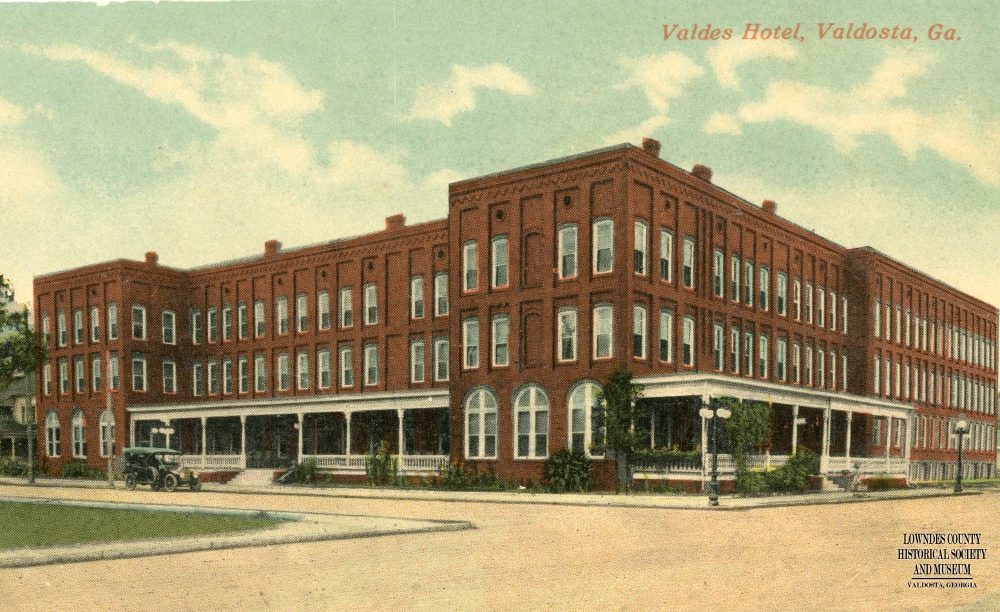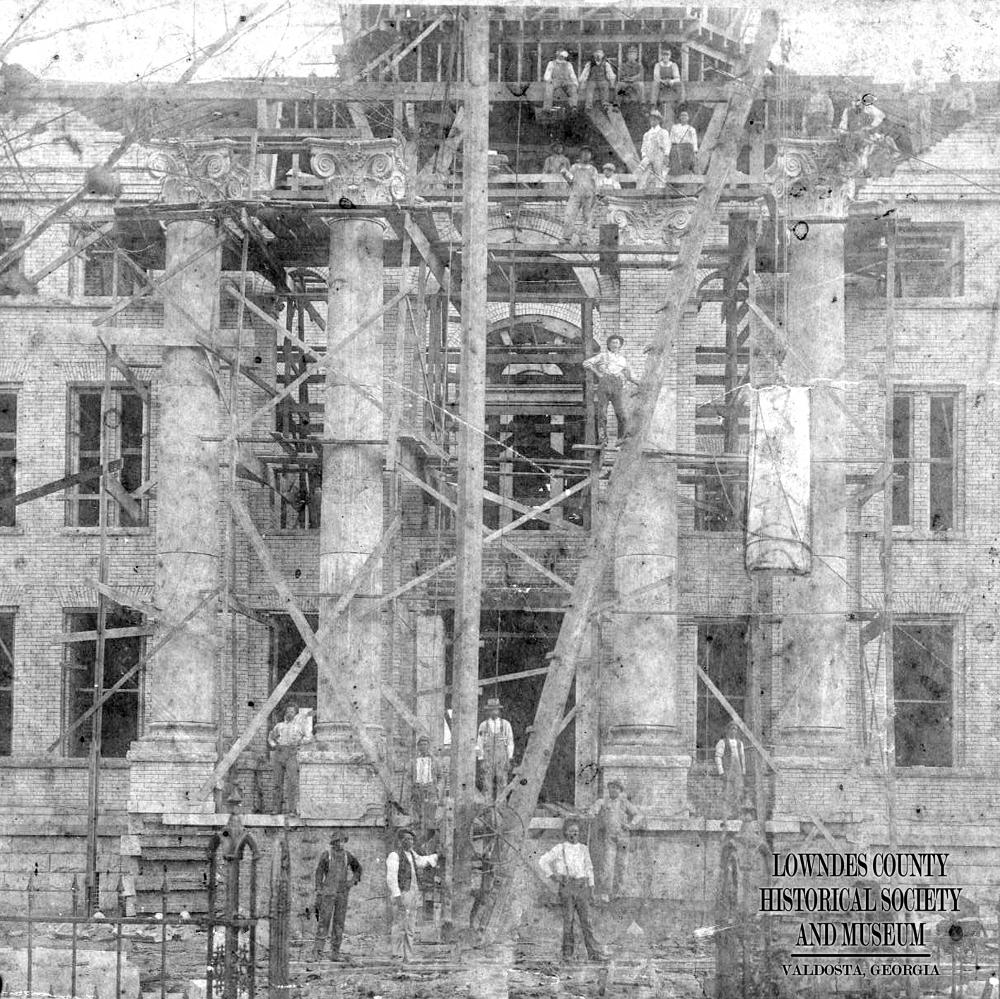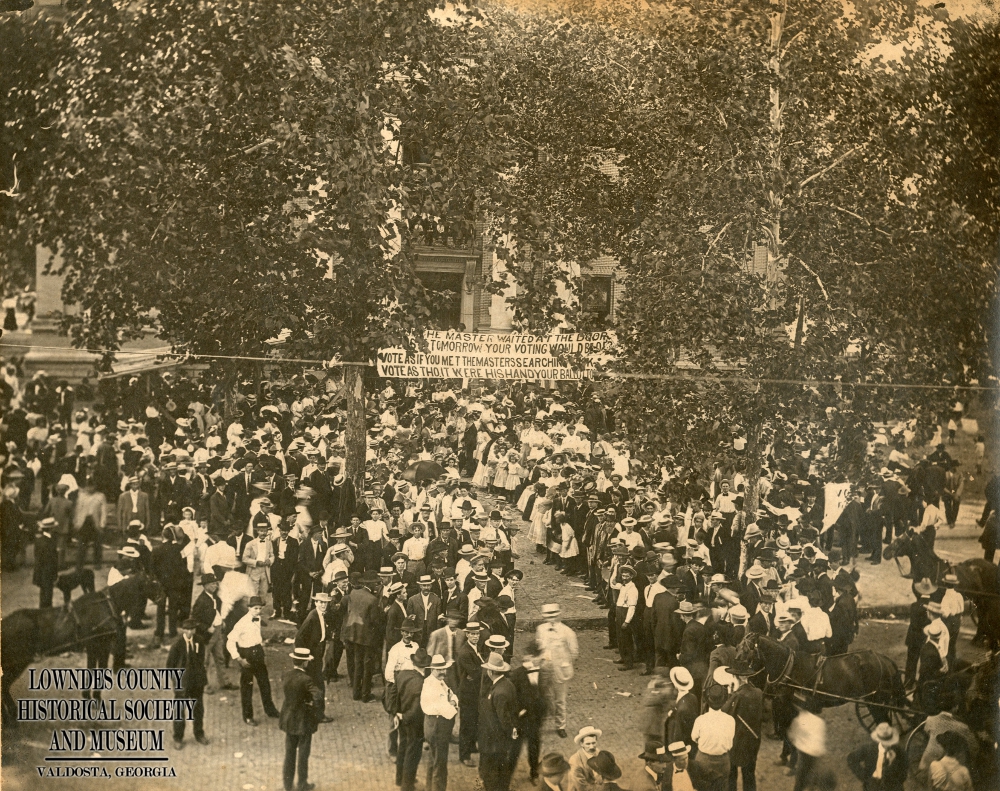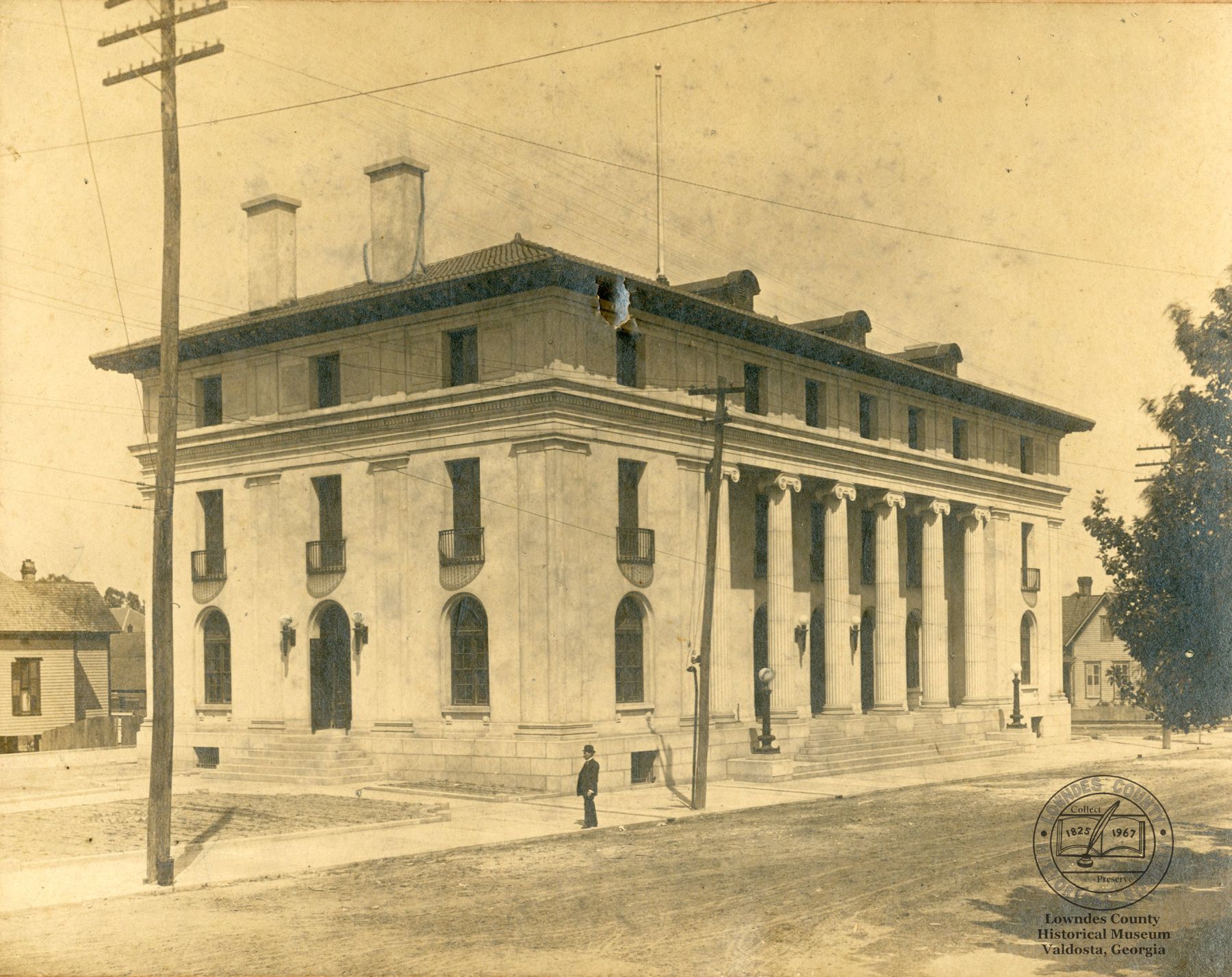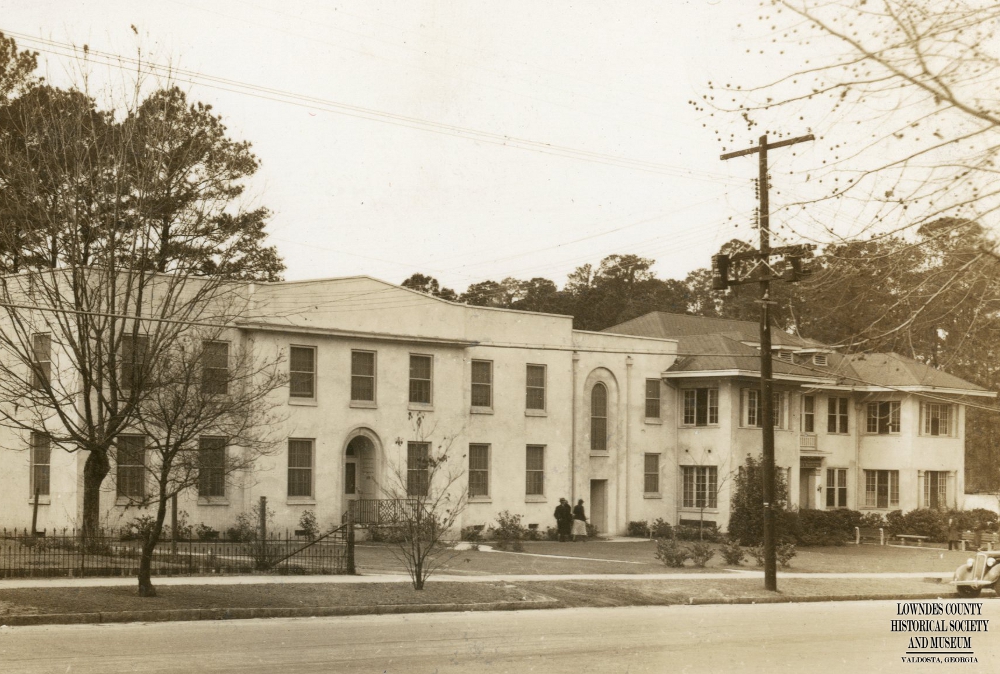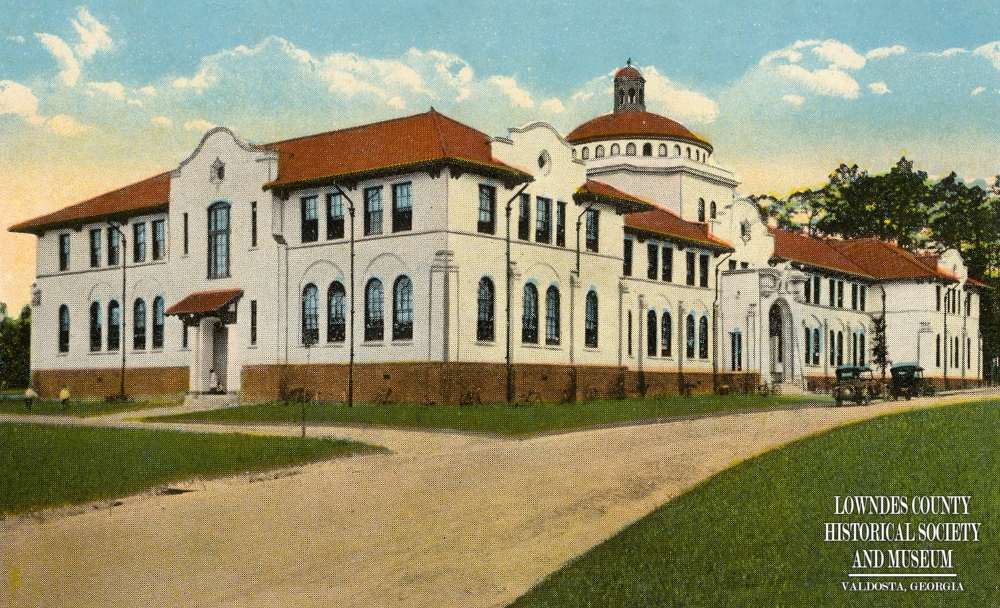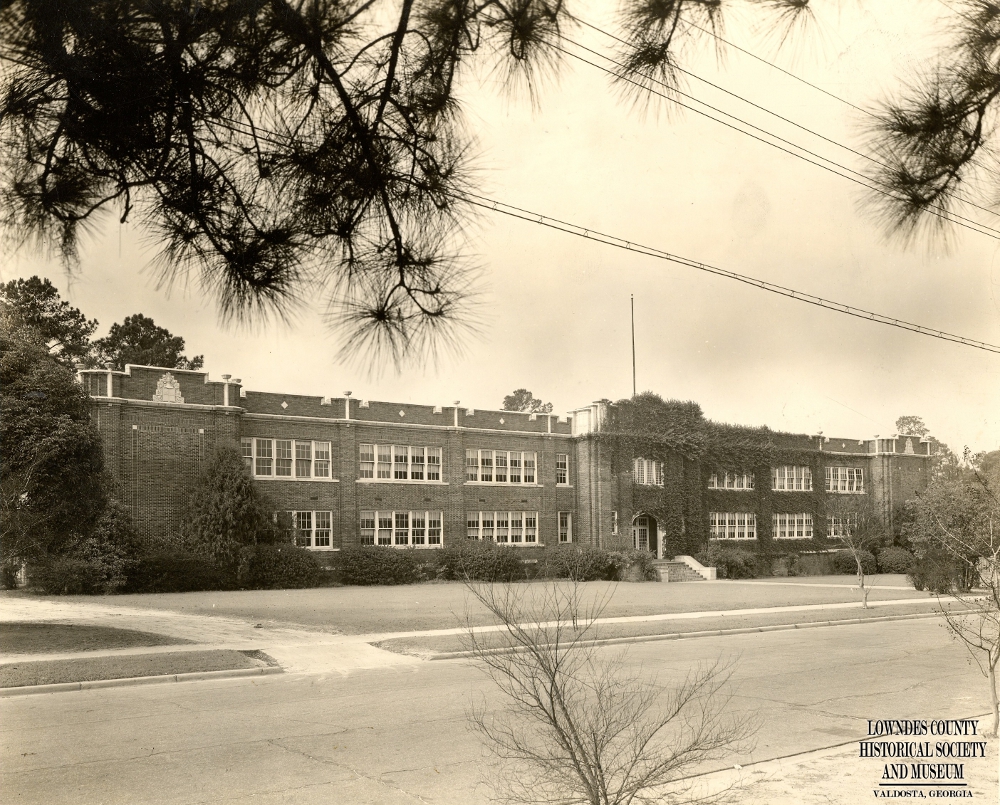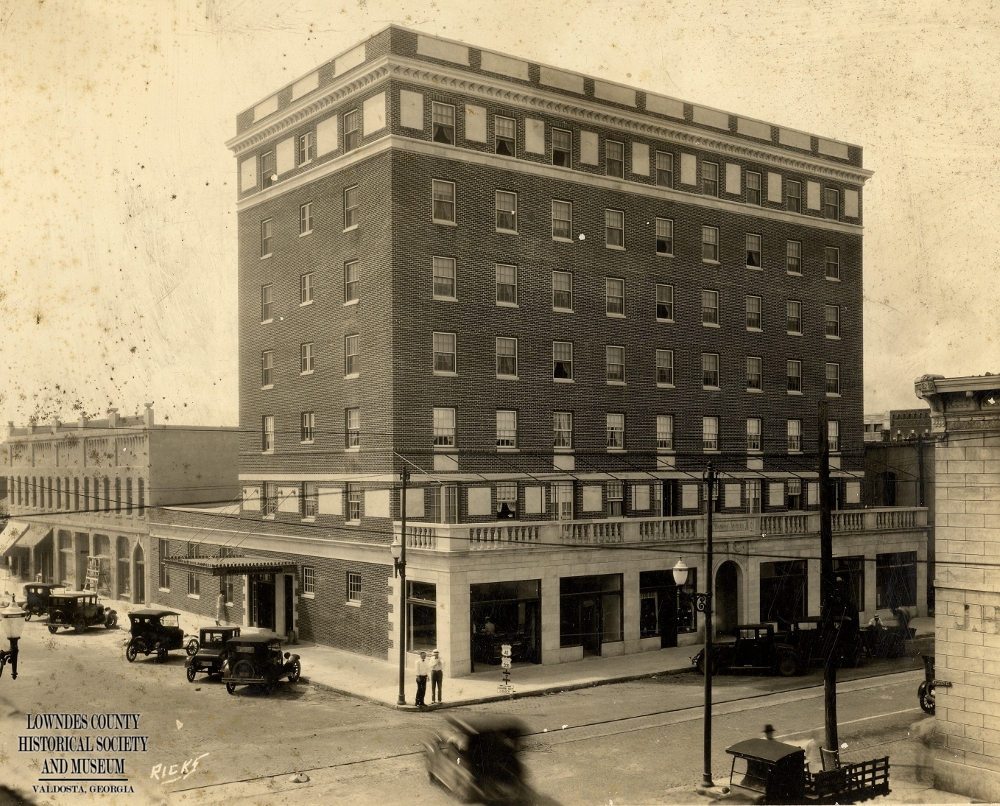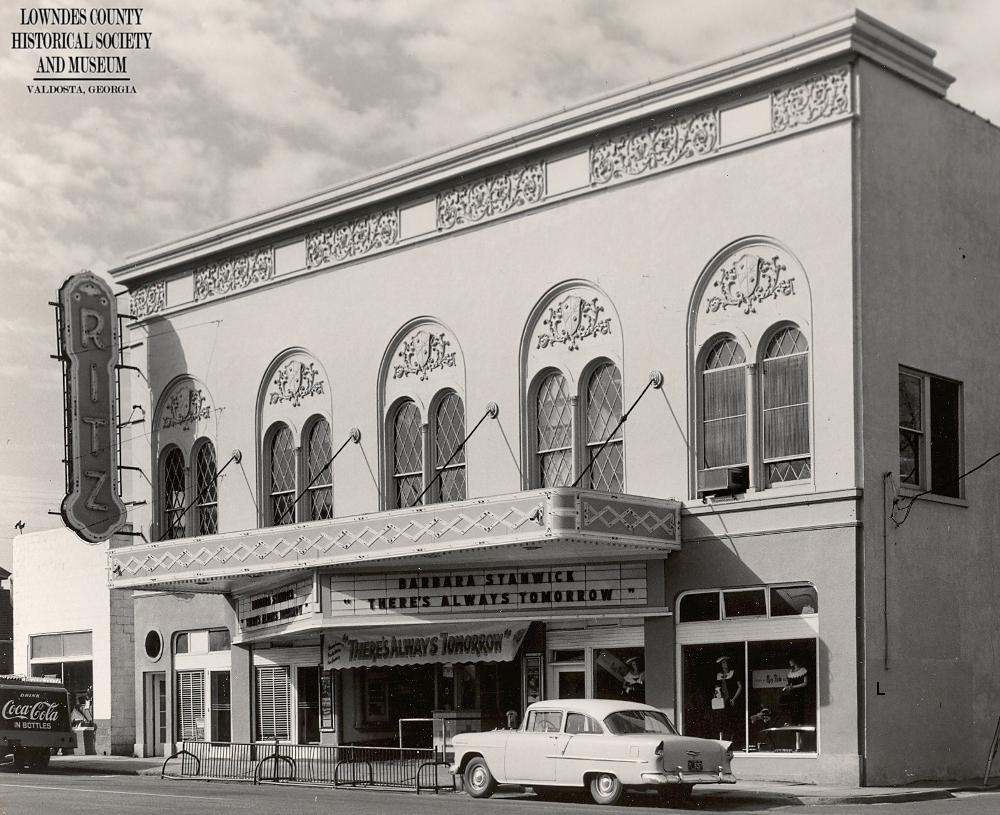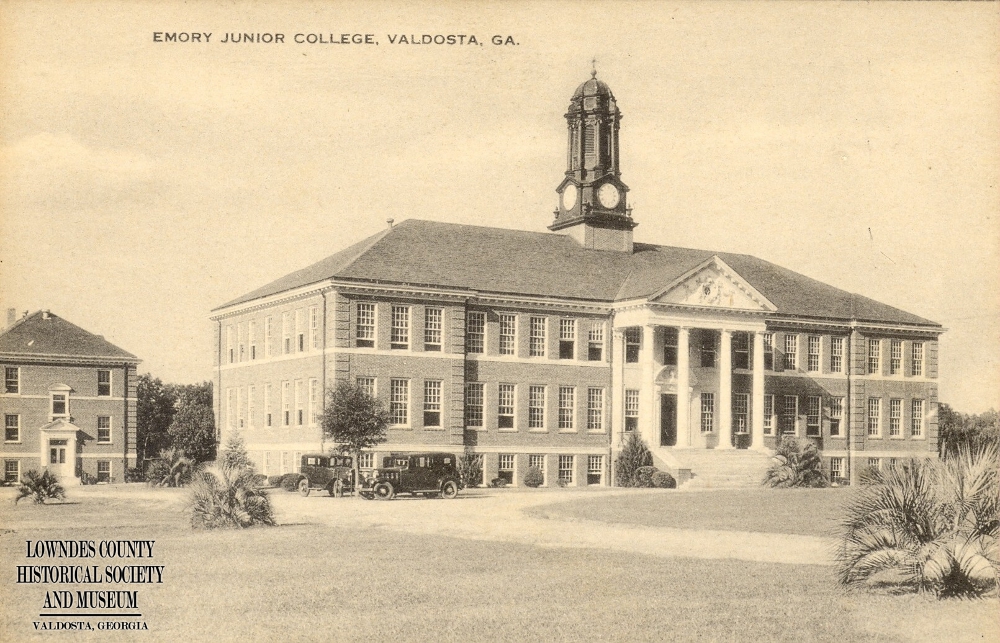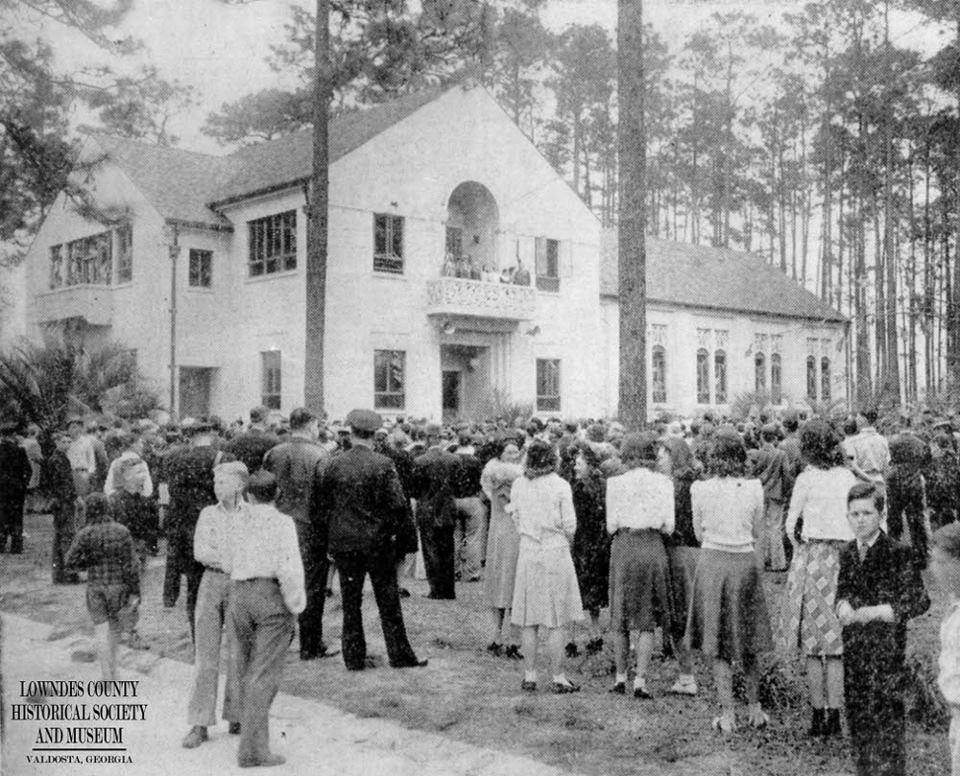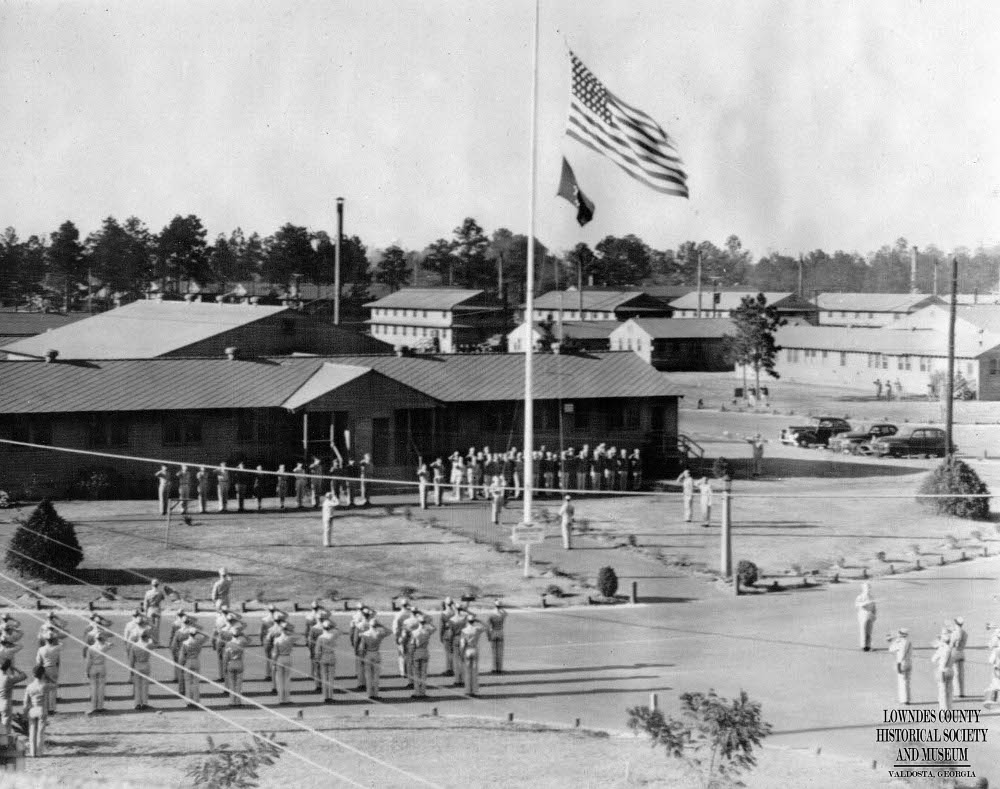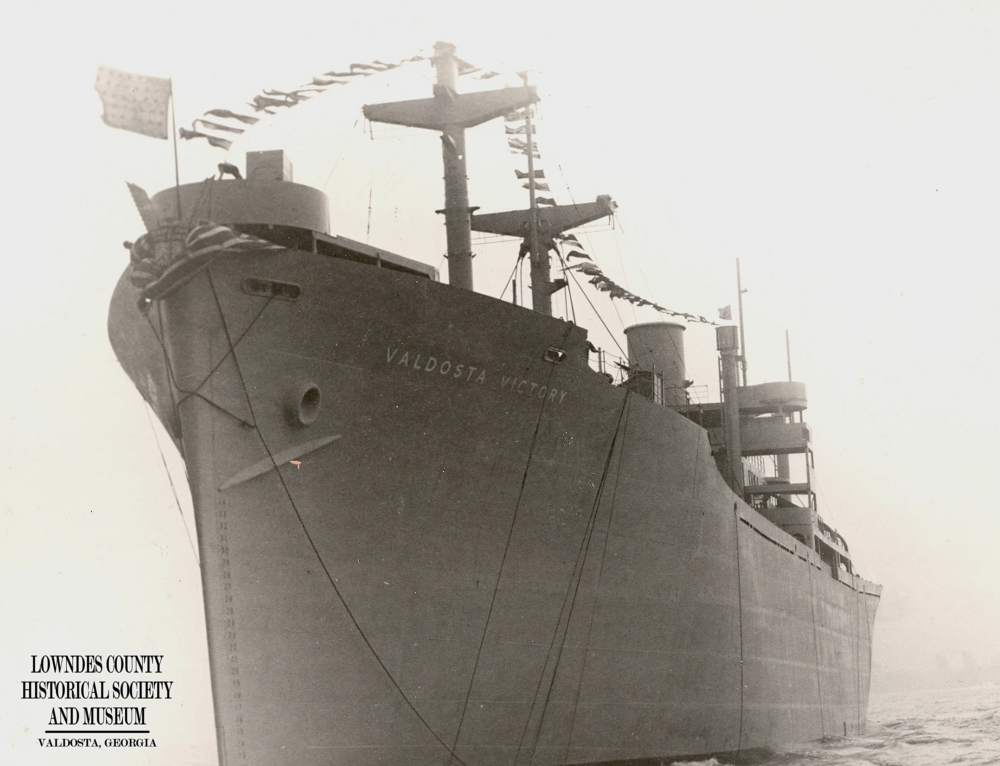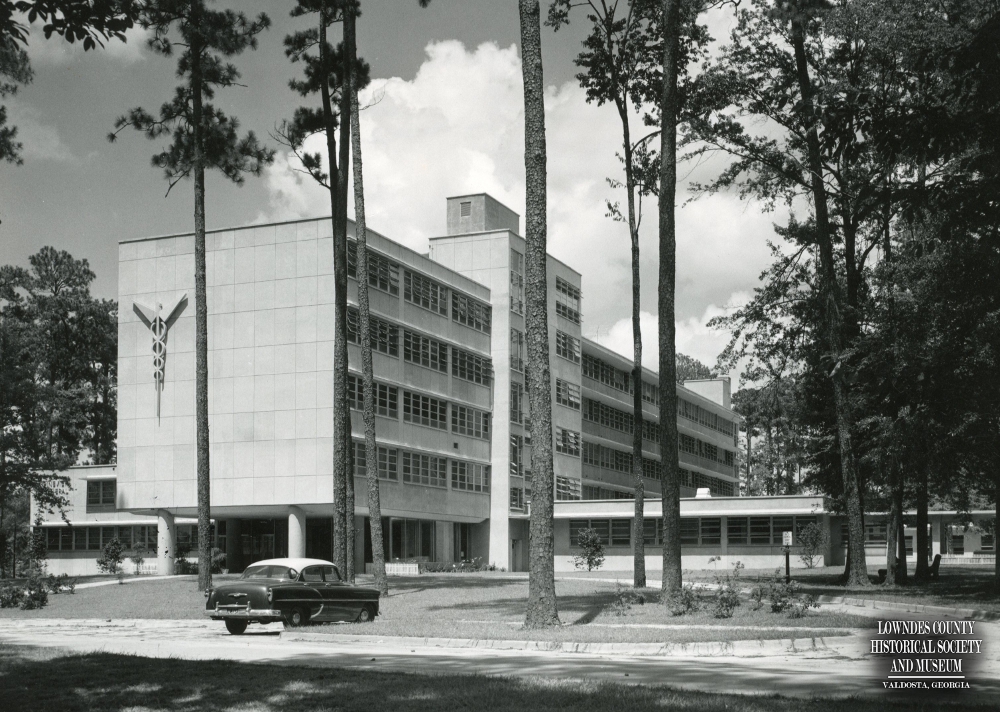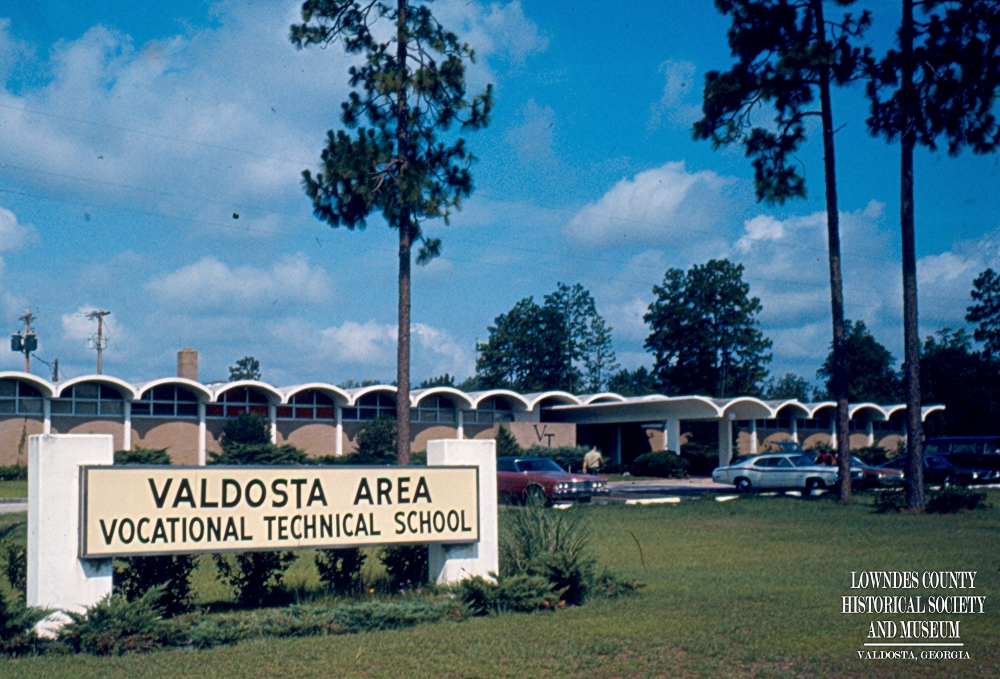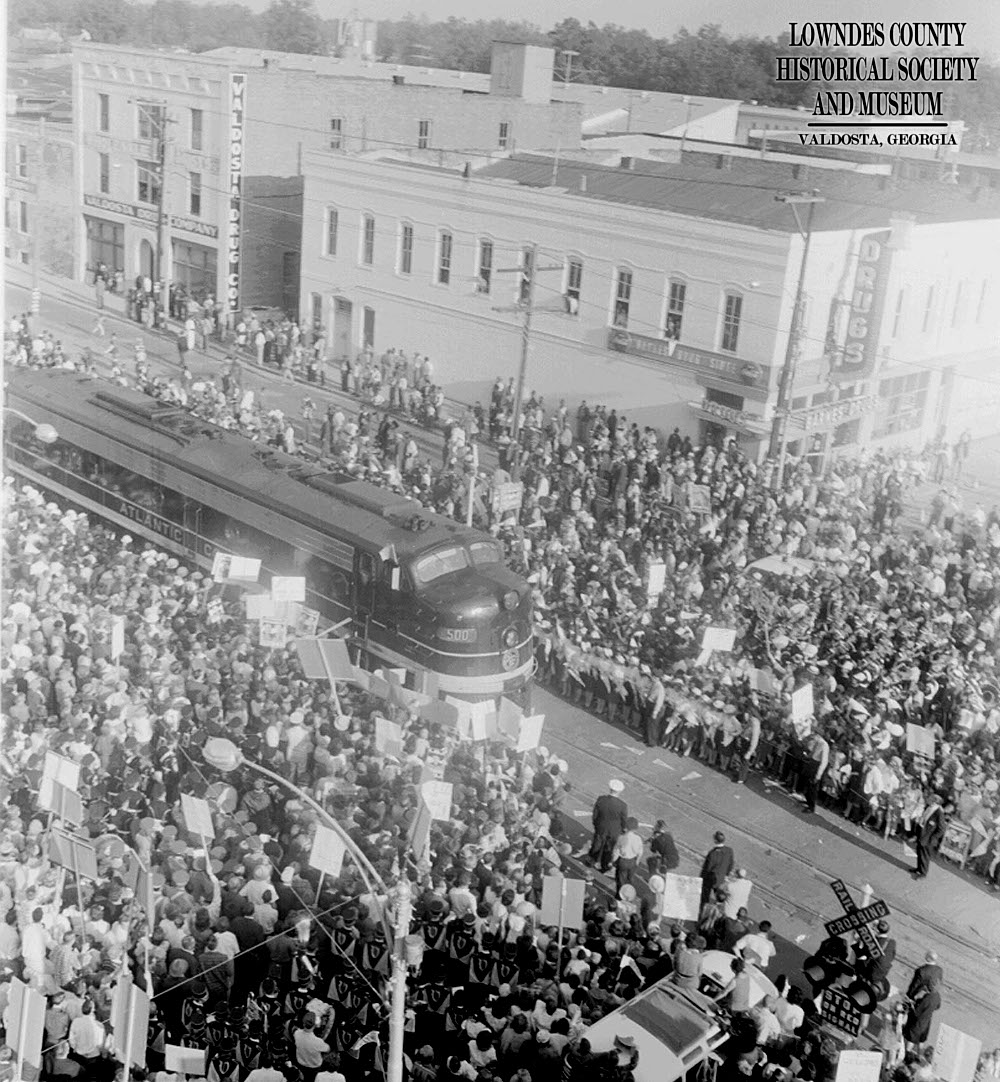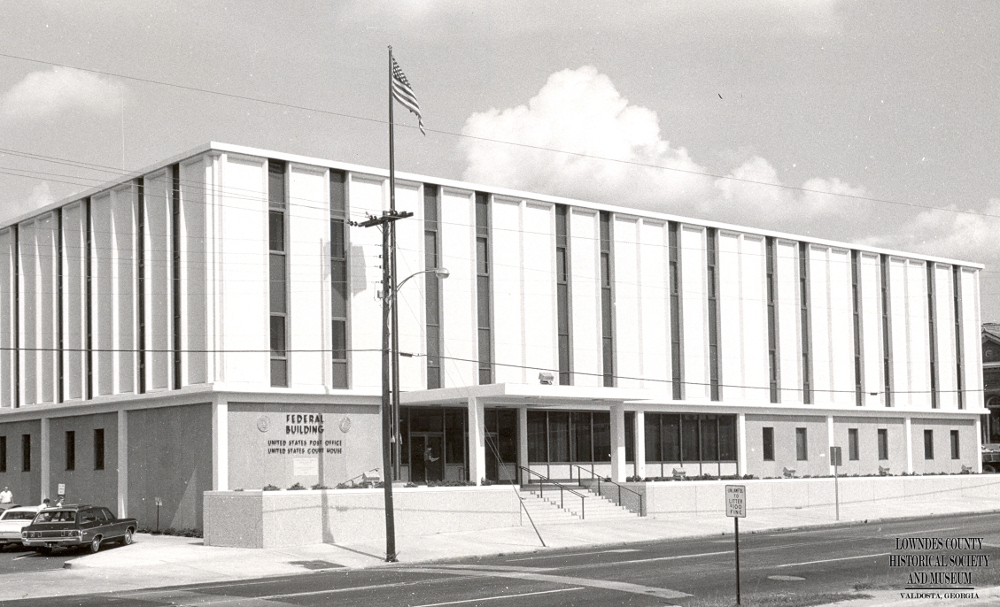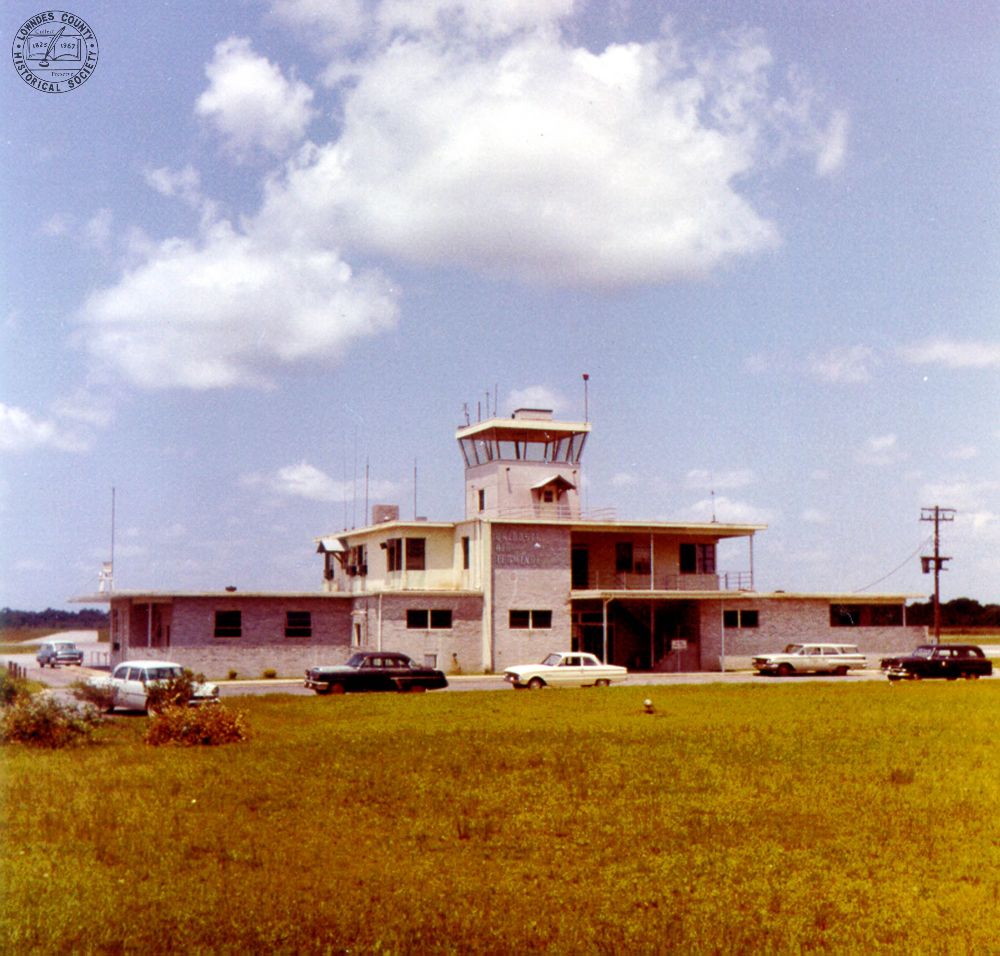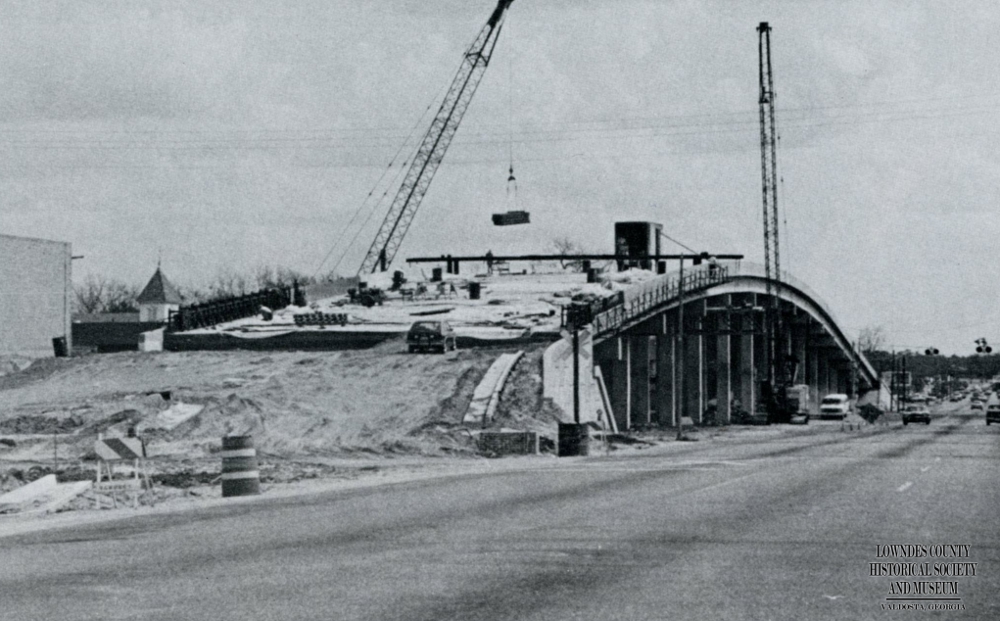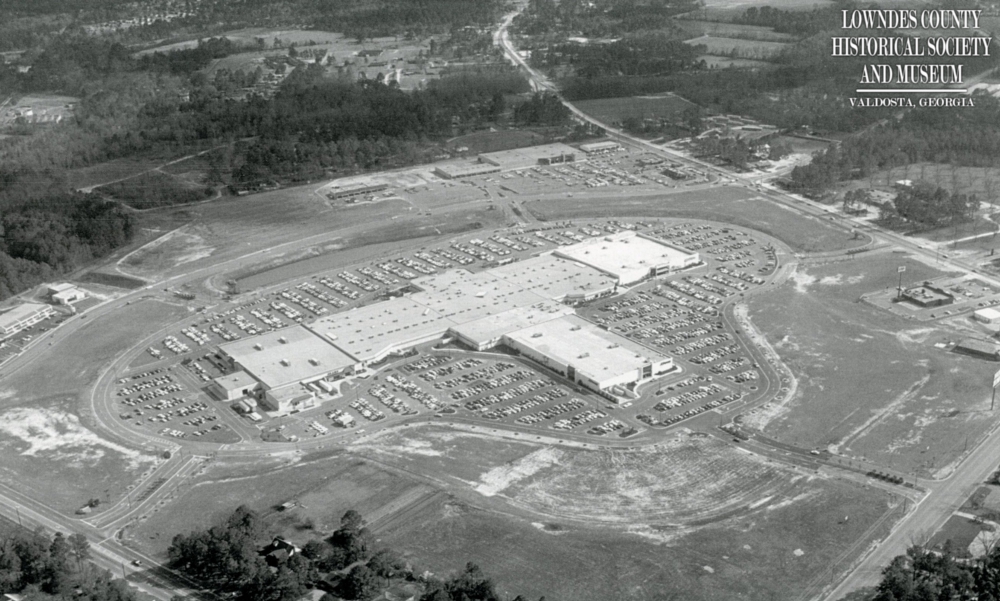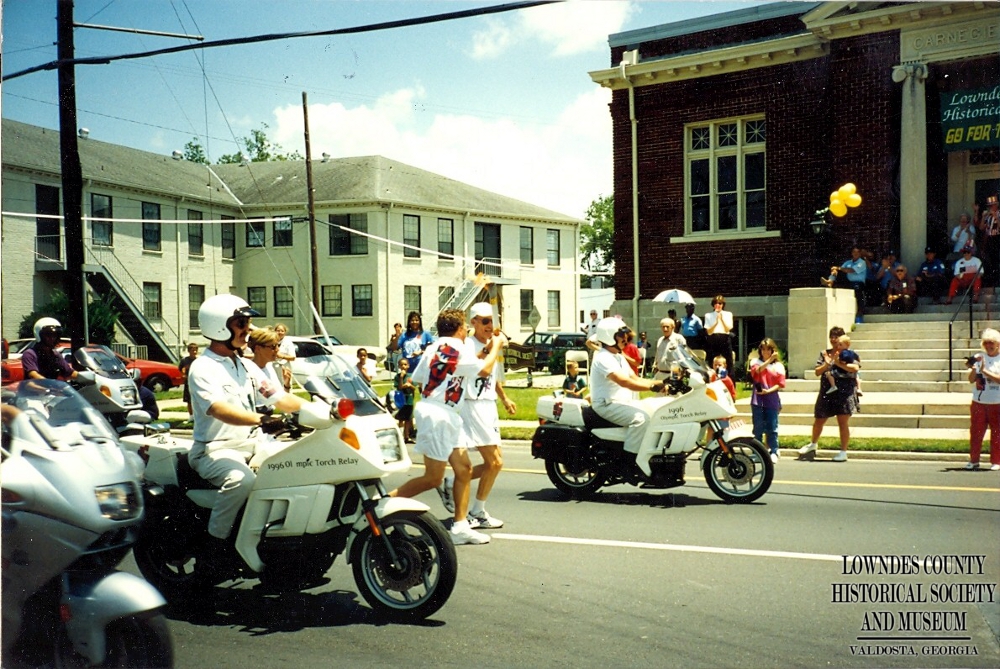Click on blue links to see online exhibits on related topics on our website.
1820
• Lots of 490 acres in Irwin County went to lucky winners in the Land Lottery. If a man’s name was drawn with a lot number he paid a fee of $18 to the state and gained the lot.
1825
• Lowndes County was created on December 23 from the southern part of Irwin County.
1826
• Following an election, county clerks, a tax collector, sheriff, coroner and surveyor were sworn in as the first officials of the newly formed County of Lowndes.
1828
• Franklinville, the first county seat, was laid out near the Withlacoochee River in the northeast section of the county.
1837
• Troupville became the county seat of Lowndes. By 1860, the tree-lined village at the confluence of the Little and Withlacoochee Rivers thrived with a court house, a famous hotel “Tranquil Hall”, several stores and shops, and a newspaper, The South Georgia Watchman.
1840
• The first Baptist congregation was organized in Troupville by seven charter members, two of whom were black slaves.
1850
• Clinch County was formed from parts of Lowndes and Ware County.
1856
• Berrien and Colquitt Counties were created from parts of Lowndes.
1858
• Brooks County was created form Lowndes and Thomas Counties and Echols from Lowndes and Clinch.
1860
• The city of Valdosta was incorporated by the Legislature on December 7.
• The engine known as Satilla Number Three pulled the first Atlantic and Gulf train into Valdosta.
1861
• I.H. Tillman and C.H.M. Howell, Lowndes County delegates to Georgia’s secession convention, voted with the majority for withdrawal from the union.
1863
• Lt. Reuben T. Roberds, who had been the first mayor of Valdosta, died at Knoxville, TN, as an officer of the “Valdosta Guards”.
1864
• Refugees from Liberty County, hit hard by Sherman’s march to the sea, organized what came to be known as the First Presbyterian Church in Valdosta.
1865
• James L. Pierpont taught music in Valdosta. He was later to compose “Jingle Bells”.
• Federal troops of Company “G”, 103rd U.S. Colored Troops, were stationed in Valdosta.
1866
• Samuel McWhir Varnedoe founded the county’s first real school, the Valdosta Institute.
1867
• The South Georgia Times, predecessor to the Valdosta Daily Times, started publication.
1868
• Alvin B. Clark, the last agent of the Freedman’s Bureau for Lowndes, Brooks and Berrien Counties resigned and became tax collector.
1869
• Fire in the office of the Ordinary, W. H. Dasher, destroyed records of the County.
1875
• A brick Court House was built on the Court House Block and was used until a new one was built in 1904-05.
• The Lowndes Volunteers, a home guard militia group, was organized with uniforms modeled after West Point.
1880
• The census reported the Naylor community had a population of 1,688 and the Valdosta community a population of 1,515.
1885
• The town purchased the private Valdosta Institute, thereby establishing a public school system.
1889
• The Georgia Southern and Florida Railroad arrived in Valdosta from the north, expanding trade and business greatly.
1890
• The Valdosta Videttes, a voluntary military company commanded by James O. Varnedoe, drilled on the public square between Ashley and Lee Streets.
1895
• Valdosta’s first City Hall was constructed
• The Valdosta City Council authorized the erection of poles, wiring and other equipment by the Southern Bell Telephone and Telegraph Company and the Valdosta Telegraph Company.
1896
• Ringling Brothers Circus appeared in Valdosta for the first time.
1898
• B.F. Strickland incorporated the iconic cotton mill in Remerton.
• The Valdosta Street Railway Company secured the right to operate street cars on Toombs, Patterson, Ashley, Lee, Troup, Hill, Central, Crane and Gordon Streets.
1899
• A fire in Lake Park destroyed 14 buildings in the business section.
• The state fair attracted visitors from considerable distances to see the area’s arts and industries, prize winning livestock and long staple Sea Island cotton.
• Local citizens celebrated the arrival of the Atlantic, Valdosta and Western railroad. The third line to arrive in the county.
1900
• The Wymodausis Club, the first women’s club in Valdosta, organized and elected Mrs. Mattie R. Stevens president.
1901
• Valdosta Chapter 471, United Daughters of the Confederacy, was organized.
1902
• The City Council passed the first sanitary ordinance upon completion of the new sewer line.
• Valdes Hotel opened at the corner of Toombs and Hill Avenue.
• Gypsy, a circus elephant, belonging to a traveling show, went on a rampage through Valdosta.
1903
• Street paving began on Hill Avenue, using “vitrified bricks” and granite curbing.
1904
• Construction began on the Lowndes County Courthouse.
• The 4-story McKey building in downtown Valdosta was built from Florida orange grove profits
1905
• The Valdosta High School on Central Avenue was built.
• The first paid fire department was established with one chief and four firemen.
• The Valdosta Times began printing a daily newspaper.
1907
• Lowndes County went dry after local ministers and church women conducted a campaign that overwhelmingly convinced voters to support Prohibition.
1908
• Rabbi Levine was called to Valdosta to minister to the Jewish community, which consisted of about 16 families by 1913.
• J. N. Bray Lumber Company was established
• The General James Jackson Chapter of the Daughters of the American Revolution was organized.
1910
• The Valdosta City Council set speed limits at eight miles an hour within the fire limits and twelve miles an hour beyond.
• The Post Office and Federal Building at the corner of Lee Street and Central Avenue was completed. The structure now serves as the Valdosta City Hall.
1911
• The Confederate Memorial constructed by the UDC on the courthouse square was dedicated.
• The Lowndes County Board of Health was created.
1912
• The Valdosta-Lowndes County Chamber of Commerce was established J. T. Blalock was the first president.
1913
• South Georgia State Normal College (now VSU) opened.
• Valdosta High School fielded its first football team.
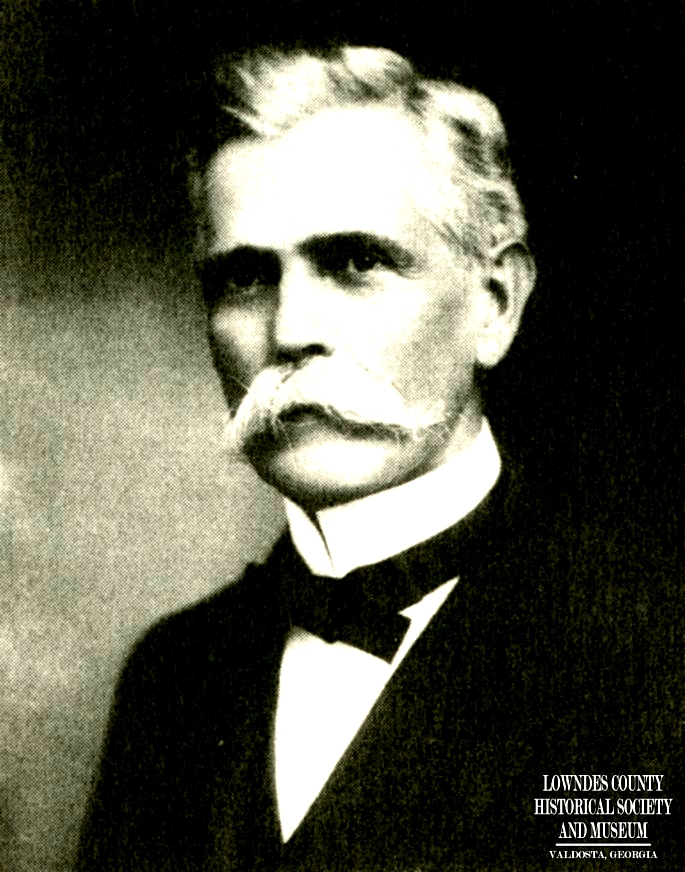 1914: Col. W. S. West
1914: Col. W. S. West1914
• Col. W. S. West appointed U.S. Senator
• The Carnegie Library of Valdosta opened
• South Georgia Pecan Company was established.
1915
• Little-Griffin Hospital was erected on North Patterson Street.
• The boll weevil fist appeared in Lowndes County cotton fields. The crop of 1917 was devastated.
1916
• Georgia and Florida Railroad hired a tobacco expert to assist farmers in handling flue-cured tobacco.
• The Valdosta Country Club was organized.
• Five prominent Valdosta businessmen and civic leaders: William S. West, Lowndes W. Shaw, Leonard F. Shaw, Daniel C. Ashley, and Owen K. Jones donated 11 acres to the city to create a public park on Brookwood Drive. The park was renamed for Richard J. Drexel in 1979
1917
• Lowndes County supplied timber, naval stores, cotton, and food stuffs to the war effort. Nearly 1,300 men and women from Lowndes County served in the armed forces.
• West Hall was completed at Georgia State Womans College and was named in honor of U.S. Senator William S. West.
1918
• Lanier County was formed from Lowndes, Berrien and Clinch Counties.
1919
• Twenty-one charter members established the Rotary Club of Valdosta.
1922
• The Valdosta High School on Williams Street was built.
• South Georgia State Normal College became a four year institution and was renamed Georgia State Womans College.
1923
• The first tobacco market in Lowndes County opened in Hahira.
1924
• The Salvation Army began operations in Valdosta.
1925
• The Daniel Ashley Hotel, the social center of Valdosta for many years, was constructed.
1926
•The Ritz, Valdosta’s grand theater, (not to be confused with the Dosta Theatre) opened downtown.
1928
• Emory Junior College in Valdosta was established. The former institution is now the north campus of Valdosta State University.
1930
• The City Council purchased 500 acres of land on the Madison Highway for an airport.
1932
• American Legion Home built.
1933
• Lowndes County became involved in the Civil Works Administration, a federally created work relief program that employed men and women hard hit by the depression.
1934
• The first electric traffic signals were installed in Valdosta.
1936
• The W.P.A. operated sewing rooms in Valdosta, Hahira and Lake Park, giving jobs to unemployed women and producing thousands of garments to be distributed to persons in need of clothing.
• Harley Langdale and others formed the American Turpentine Farmers Association.
1941
• Eleanor Roosevelt dedicated the new library at The Georgia State Woman’s College.
1942
• Moody Field opened as a pilot training base during WWII.
1944
• The Valdosta Victory ship, named in recognition of the community’s support for war bond sales, was christened at the Bethlehem Steel Shipyard in Baltimore
1946
• National Airlines inaugurated commercial air service to Valdosta.
1950
• Georgia State Womans College became a coed institution and was renamed Valdosta State College.
1953
• In October, the first carload of pulpwood was delivered to National Container Corp., which later became Owens-Illinois.
1955
• Pineview General Hospital, now South Georgia Medical, opened.
1962
• Groundbreaking held for Valdosta Area Vocational – Technical School (now Wiregrass Georgia Technical College).
1963
• Interstate Route 75 into Florida was officially opened
1964
• Seven thousand citizens turned out to greet the wife of U.S. President Lyndon B. Johnson when the “Lady Bird Special” railroad tour stopped in the area.
1966
• Several county high schools were consolidated to form the current Lowndes High School.
1967
• Five Points Shopping Center opened at the convergence of North Patterson, Ashley and Oak Streets.
1969
• The Post Office and Federal courthouse and offices moved to new home on Patterson Street from 1910 post office.
• Valdosta High School and Pinevale High School were consolidated.
1971
• Coach Wright Bazemore retired after leading the Valdosta Wildcats to nearly 300 victories and 14 state championships.
1972
• The Valdosta High School campus on Forrest Street opened.
1975
• Valdosta Municipal Airport opened expanded facilities, and Southern Airways instituted jet service.
1977
• The former Valdosta High School on Williams Street was destroyed by fire.
1978
• Converse Hall, the first building constructed at South Georgia State Normal College (VSU) in 1913 was destroyed in a fire.
1981
• The Chamber of Commerce opened their office in the renovated historic E.R. Barber House.
• The first official “Winnersville Classic” football game between Lowndes and Valdosta High School was held.
1982
• The James M. Beck overpass opened downtown
1983
• The Valdosta Mall opened
• The Converse-Dalton-Ferrell home was added to the national register of historic places
1993
• Valdosta State College received university status, becoming Valdosta State University.
1996
• The Olympic torch was taken through Valdosta on its way to Atlanta for the Centennial Olympic summer games
2000
• Census data representing the population growth in the region resulted in Valdosta being named a Metropolitan Area.
2005
• Georgia Governor Sonny Perdue declared Valdosta the states first “Entrepreneur Friendly Community.”
2008
• Valdosta was awarded the honor of “Titletown” by ESPN for the community’s overwhelming athletic successes.
Sources:
Pictorial History of Lowndes County 1825-1975,
Valdosta-Lowndes County Chamber of Commerce timelines published in the Valdosta Daily Times, July 31, 1988 and April 26, 1992,
and the Lowndes County Historical Museum archives.

